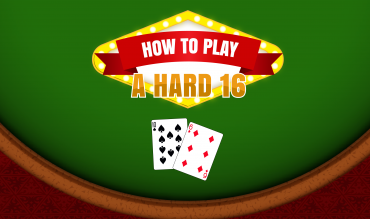In this article you will learn how to play a hard 16 when you play blackjack.
A hard 16 is a blackjack hand that contains either no Aces, or if an Ace is present, it counts as one. Some examples of hard 16 are:
- 10-6
- 7-9
- 4-4-8
- 7-8-A
HARD 16 PLAYING OPTIONS
There are three viable options: hit, stand, or surrender. Which strategy you invoke depends on what the dealer’s upcard is and the rules of the game.
HARD 16 BASIC PLAYING STRATEGY
The following generic basic playing strategy summarizes how to play your hard 16 without regard to the actual cards that comprise your hand.
- In a single- and double-deck game, surrender against a dealer’s 10 or Ace upcard, stand against a dealer’s 2 through 6 upcard, and hit against a dealer’s 7, 8, or 9 upcard.
- In a multi-deck game, surrender against a dealer’s 9, 10, or Ace upcard, stand against a dealer’s 2 through 6 upcard, and hit against a dealer’s 7 or 8 upcard.
- If the surrender option is not allowed, then hit your hard 16 instead.
HARD 16 ADVANCED PLAYING STRATEGY
A more advanced blackjack strategy with extra precision considers the composition of cards that make up your 16. For example, if your 16 is comprised of three (or more) cards, say 5 plus 6 plus 5, it is played differently than if it is comprised of, say, a 10 plus 6. The composition-dependent strategy is as follows:
- If your hard 16 is comprised of three (or more) cards, in all cases, you should follow the above strategy for hard 16 with this exception:
- Stand on 16 (instead of surrendering) against a dealer’s 10 upcard.
- In a single-deck game with s17, hit a 9 plus 7 against a dealer’s Ace upcard (instead of surrender).
Additionally, if the hard 16 is the result of a pair split, then stand (instead of hit).
REASON FOR THE STRATEGY
A hard 16 is one of the worst hands you can get when you play blackjack because you will lose more hands than you win no matter what strategy you invoke. However, you can minimize your losses if you follow the previous playing strategy.
The reason you should surrender a hard 16 is when your chance of winning is less than one out of four hands, i.e., your expected loss is worse than 50%. This means that statistically, if playing the hand has less than a 25 percent chance of winning and consequently greater than a 75 percent chance of losing, you will save money in the long run by surrendering the hand instead. This is the case with surrendering hard 16 per the previous strategies.
The reason you stand on hard 16 when the dealer’s upcard is small (namely 2 through 6) is because the dealer’s chances of busting are relatively high (35 to 42%). In this situation, you don’t want to risk busting your hard 16 hand by drawing another card because you automatically lose even if the live blackjack dealer subsequently busts in the same round.
When the dealer’s upcard is 7 through Ace, the probability of the dealer’s busting is lower, and she or he is more likely to make a pat (17 through 21) hand. In this situation, you are better off hitting 16 (if surrender is not a viable option), even at the risk of busting, since you will lose less in the long run (compared to standing).
In the case of a multi-card 16, you should stand instead of hit against a dealer’s 10 upcard because of these reasons:
- By having just one small-value card in your hand when you hold , say a 4 plus 6 plus 6, you increase the chances that the dealer will bust with a hit just enough to tip the balance in favor of standing (rather than hitting).
- You also decrease your own chances of filling the hand with a hit, since you already hold two cards that you’d like to get when you hit.
SUMMARY
Keep these rules in mind before surrendering, hitting, or standing on a hard 16 and you will always lose less in the long run.
For a complete basic playing strategy for any given mix of playing rules, consult Chapter 3 in the Ultimate Blackjack Strategy Guide.
